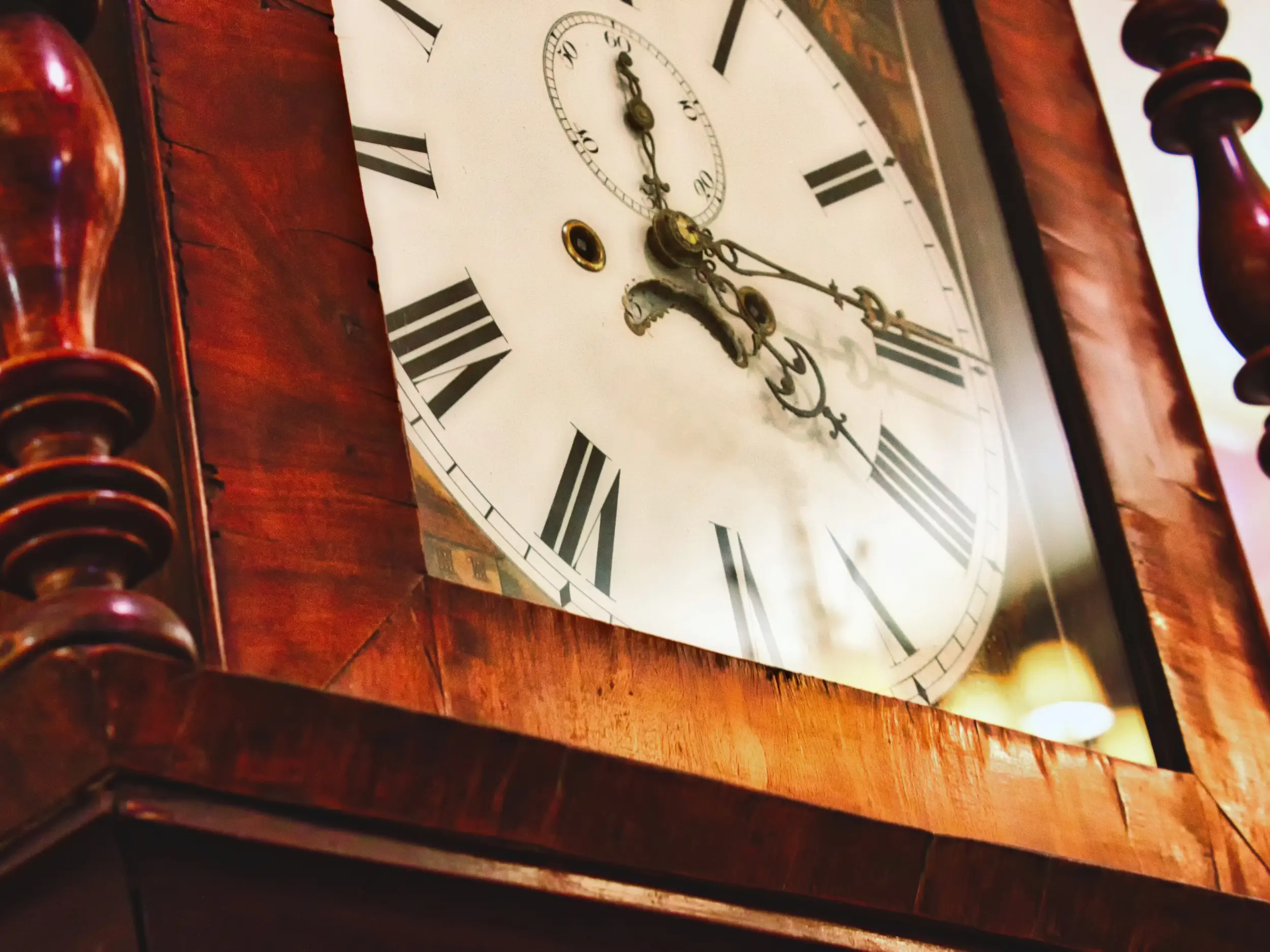
So, you’re moving, and that beautiful, stately grandfather clock that has been the heart of your home needs to come with you. We get it—the thought alone can be enough to make your heart skip a beat. These magnificent heirlooms are more than just furniture; they're intricate machines and cherished pieces of history. Moving one is a delicate operation that requires patience, precision, and a whole lot of care.
But don't worry, you're not alone! Whether you're a dedicated DIYer or already feeling overwhelmed, this guide is for you. We’ve compiled expert tips from seasoned grandfather clock movers to walk you through the process safely.
Read on for our step-by-step advice on how to move a grandfather clock. And remember, if at any point you think, "Yikes, this is too much!"—our friendly, licensed, bonded, and experienced team at Pick and Pack Moving is just a phone call away. We're here to handle the heavy lifting so you can have peace of mind.
Why Moving a Grandfather Clock is a Specialty Job
Moving a long case clock isn't like moving a bookcase. It's a complex task that demands a special touch. This section will help you understand what you're up against, ensuring you give your antique timepiece the respect and care it deserves.
Preparation Before Moving
Before you lay a finger on the clock, planning is key. Start by consulting the owner’s manual if you have it—it often contains specific disassembly instructions.
| Task | Notes & Important Reminders |
|---|---|
| Locate Owner's Manual | Crucial first step! The manual often has model-specific disassembly instructions for the clock mechanism, weights, and pendulum. |
| Measure the Clock | Record the full height, width, and depth of the clock case. Don't forget to include any protruding leveling feet or decorative top pieces. |
| Measure the Path | Measure doorways, hallways, stairwells, and tight corners at both your current and new home. Ensure there's ample clearance for the clock's height and width. |
| Gather Packing Materials | Collect moving blankets, bubble wrap, packing paper, painter's tape, zip-top bags, and markers for labeling. |
| Secure Help | Decide if you are using friends or hiring professional grandfather clock movers. Ensure you have at least two strong helpers confirmed for moving day. |
| Prepare the Path | On moving day, completely clear the path of rugs, floor lamps, toys, and other tripping hazards. |
| Plan for Placement | Decide on the clock's final location in the new home. Ensure the floor is stable and not uneven to avoid future timing issues. |
Assessing the Moving Environment
Take a walkthrough of the path you’ll use. Look for tight corners, low-hanging light fixtures, or stairwells that could pose a challenge. Clear the path completely of rugs, toys, and other obstacles. For a grandfather clock, a clear and wide pathway is non-negotiable.
Gathering Necessary Tools and Materials
You can’t do a professional job without the right gear. Before you start, gather these essential packing materials:
- Moving blankets and furniture pads
- Bubble wrap and packing paper
- Strong packing tape
- Zip-top bags for small components
- A soft cloth
- A winding crank (if your clock has one)
- A hand truck or dolly with straps
Carefully Disassembling the Grandfather Clock
This is the most critical phase. Rushing here can lead to costly damage to the clock mechanism.
Remove Weights Safely
Open the front door and you’ll see the heavy weights. Carefully unhook them one at a time. They are often different, so mark each one (e.g., Left, Center, Right) as you remove them. Wrap each weight individually in bubble wrap and place them in a sturdy box lined with packing paper.
Detach the Pendulum
Gently stop the pendulum from swinging. With two hands, carefully lift it straight up and off its hook. This brass component is extremely delicate. Wrap it generously in packing paper and bubble wrap, and secure it in a long, narrow box if possible.
Protect Glass Panels and the Clock Face
The glass side panels and door are vulnerable. Tape a large "X" across each glass panel with painter's tape (it doesn't leave residue) to hold it in place if it shatters. Then, pad the entire clock case with moving blankets, securing them with tape to the clock's body, not the glass.
Secure Internal Mechanisms
For some antique clocks, it may be necessary to secure the chime rods or chime hammers with foam and tape to prevent them from bouncing during transit. If you're unsure, this is a step where local grandfather clock repair specialists or professional moving experts can be invaluable.
See our team expertly take apart and pack a grandfather clock to ensure it moves safely.
Check out our material guide for this process:
| Material | Purpose | Why It's Important |
|---|---|---|
| Painter's Tape (Blue Tape) | To create an "X" over the glass panels and the door. | It holds glass securely without leaving a sticky residue on the finish of your antique clocks. |
| Moving Blankets | To wrap and protect the main clock case. | Provides thick cushioning against scratches, dings, and impacts during the move. |
| Bubble Wrap | To individually wrap the weights, pendulum, and other delicate parts. | Offers excellent shock absorption for heavy and fragile components. |
| Packing Paper | To line boxes and provide extra padding between wrapped parts. | Prevents wrapped items from shifting and rubbing against each other inside boxes. |
| Zip-Top Bags (Various Sizes) | To store small hardware like screws, keys, or the winding crank. | Keeps all tiny but crucial parts organized and prevents them from getting lost. |
| Permanent Marker | To label bags and boxes (e.g., "Left Weight," "Pendulum"). | Ensures easy identification during reassembly. |
| Sturdy Cardboard Boxes | To hold the wrapped weights and pendulum. | Provides a rigid container to protect disassembled parts from being crushed. |
| Soft, Lint-Free Cloths | For handling the clock face and polished brass components. | Prevents fingerprints and fine scratches on delicate surfaces. |
| Foam Padding or Pool Noodles | To secure internal chime rods and mechanisms. | Cushions and immobilize delicate internal parts to prevent damage during transit. |
Pro Tip: Our professional grandfather clock movers can provide you with all of these materials and a professional touch. We're just one phone call away.
Transporting Your Grandfather Clock
Now, this is the part where your preparation pays off and you thank yourself for following a professional guide.
Deciding on Upright vs. Flat Transportation
The golden rule is to always transport a grandfather clock upright in the moving truck. Laying it flat puts immense pressure on the internal clock movement and case, which can lead to catastrophic failure. If you're using a truck rental, ensure the vehicle is tall enough to accommodate the clock standing up. If you're working with Pick and Pack Moving, we ensure the safety of your grandfather clock so you don't have to worry about it being damaged during transportation.
Securing the Clock During Transit
Once in the truck, place the clock against a wall and use moving straps to secure it firmly to the wall anchors. Pad the straps where they touch the clock to avoid scratching. Surround it with other soft items like mattresses or padded furniture to prevent it from shifting during transit.
Reassembling the Clock in Its New Home
You've arrived! Now it's time to bring your clock back to life and carefully reassemble it. This process also takes precision and care, so follow the guide to the tooth.
| Step | Task | Key Details & Pro Tips |
|---|---|---|
| 1 | Position the Clock Case | Move the main clock case to its permanent location. Use the leveling feet to ensure the clock is perfectly stable and straight from every angle. An unlevel clock will not keep accurate time. |
| 2 | Reinstall the Pendulum | Carefully unwrap the pendulum. With two hands, gently lower it onto its hook behind the clock movement. Ensure it is hanging freely and straight. |
| 3 | Rehang the Weights | Unwrap the weights. Referring to the labels you made during disassembly, hang each weight on its correct chain or cable (Left, Center, Right). Incorrect placement can damage the clock mechanism. |
| 4 | Reattach Accessories | Reinstall any removed glass panels or doors. Use your key to unlock the clock face if it was secured for transit. |
| 5 | Start the Clock | Give the pendulum a gentle, gentle swing to start it. You should hear a steady tick-tock. Do not wind the clock yet. |
Now, it's time to ensure it has the correct functionality post-move.
| Step | Task | Key Details & Pro Tips |
|---|---|---|
| 1 | Let it Settle | It is normal for the clock to take 24-48 hours to settle into its new environment and keep perfect time. Be patient. |
| 2 | Wind the Clock | Once the pendulum is swinging steadily, use the winding crank to wind the weights. Wind until the crank slightly resists—do not overwind. |
| 3 | Listen Carefully | Listen to the chime sequence. Does it sound clear, or is it sluggish? A misaligned chime hammer can cause a buzzing sound. |
| 4 | Check the Time | Over the next few days, monitor the clock's accuracy against a reliable time source. Minor adjustments to the leveling feet can help. |
| 5 | Know When to Call a Pro | If the clock doesn't run, the chime is off, or something just doesn't sound right, stop. This is the time to call local grandfather clock repair specialists for a professional fine-tuning. |
When to Call for Professional Grandfather Clock Movers?
The size and weight of a grandfather clock make it a multi-person job. So, no, you won't be able to move it on your own or with the help of your friend. We created this guide to help dedicated DIYers, but as professionals, we always recommend calling for help when you notice this job is out of your pay grade:
- You're overwhelmed by the number of steps needed to be taken
- You don't have access to the needed materials
- You're unsure if you've disassembled the clock correctly
While friends can be helpful for moving a sofa, a grandfather clock requires a specialty service. Professional grandfather clock movers have the experience, specialized equipment like a custom crate, and insurance to protect your valuable investment. Friends may have good intentions, but a single slip can mean irreparable damage.
Cost Considerations: DIY vs. Pro
The decision you make will also affect the final cost of your move.
The cost for professional grandfather clock movers is an investment in safety and peace of mind. It typically includes their expertise, insurance, and specialized equipment, protecting you from a much costlier repair bill.
A DIY move might seem cheaper initially, but factor in the cost of a truck rental, packing materials, dollies, and your valuable time. Most importantly, consider the immense financial and sentimental risk if something goes wrong. For a valuable antique, professional help is almost always the wiser choice.
Need Help? Let Pick and Pack Moving Be Your Grandfather Clock Movers
As you can see, moving grandfather clocks is a significant undertaking.
At Pick and Pack Moving, we offer the specialty service and expertise this delicate job demands. Our crews are trained to handle antique clocks and floor clocks with the utmost care, using premium packing materials and techniques. We provide everything from labor help for the heavy lifting to full-service long-distance moving, complete with secure storage options if you need them.
Why stress about your most precious possessions?
Get a transparent, free virtual estimate today and let our moving experts ensure your grandfather clock arrives at your new home safely, ready to chime for generations to come.





